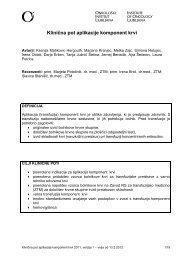Create successful ePaper yourself
Turn your PDF publications into a flip-book with our unique Google optimized e-Paper software.
Effects <strong>of</strong> model organophosphorous pesticides on DNA damage and<br />
proliferation <strong>of</strong> human hepatoma HepG2 cells<br />
Irena Hreljac, Irena Zajc, Tamara Lah Turnšek, Metka Filipič<br />
Dept. <strong>of</strong> Genetic Toxicology and Cancer Biology, National Institute <strong>of</strong> Biology, Ljubljana, Slovenia<br />
Organophosphorous compounds (OPs) are the most commonly used pesticides. The<br />
primary mechanism <strong>of</strong> OP toxicity is the inhibition <strong>of</strong> acetylcholine esterase in the<br />
nervous system leading to a variety <strong>of</strong> acute and chronic effects. Recent studies have<br />
revealed several other targets <strong>of</strong> OPs that disturb non-cholinergic biological systems.<br />
We investigated whether low concentrations <strong>of</strong> model OPs, methyl parathion, methyl<br />
paraoxon and dimefox, induce DNA damage and/or affect cell proliferation in human<br />
hepatoma HepG2 cells. Genotoxicity <strong>of</strong> OPs was evaluated using the Comet assay. The<br />
effect on cell proliferation was tested using the MTT assay and proliferation marker<br />
Ki-67 immunocytochemistry. The effects <strong>of</strong> OPs on mRNA expression <strong>of</strong> DNA damage<br />
responsive genes: p53, p21, GADD45α and MDM2 were determined using qRT-PCR.<br />
Methyl parathion induced DNA damage at lower concentrations (1 μg/mL) than methyl<br />
paraoxon (100 μg/mL), whereas dimefox did not induce DNA damage. Methyl parathion<br />
and methyl paraoxon caused a reduction <strong>of</strong> cell proliferation at their highest concentrations<br />
(100 μg/mL) while dimefox increased cell proliferation at all concentrations used (0.01-<br />
100 μg/mL). Methyl parathion and methyl paraoxon upregulated expression <strong>of</strong> DNA<br />
damage responsive genes while dimefox upregulated expression <strong>of</strong> p53, downregulated<br />
expression <strong>of</strong> p21, and had no effect on the expression <strong>of</strong> MDM2 and GADD45α. We<br />
conclude that methyl parathion and methyl paraoxon are genotoxic, while dimefox shows<br />
mitogenic activity. The important finding <strong>of</strong> this study is that methyl parathion, which<br />
has lower acute toxicity and is more extensively used, had higher genotoxic potential than<br />
methyl paraoxon. This warrants for further investigations in order to correctly evaluate<br />
the hazard <strong>of</strong> exposure to these chemicals.<br />
p1799
















